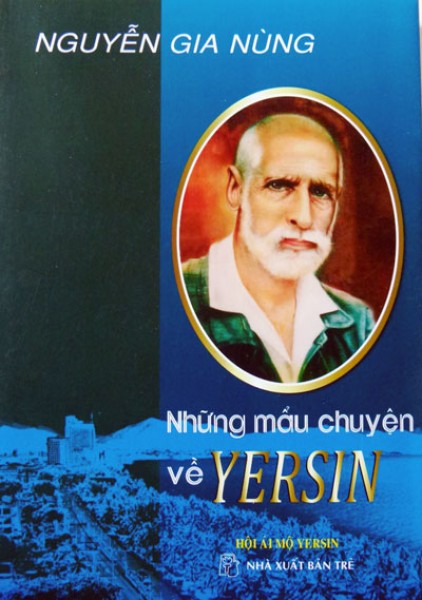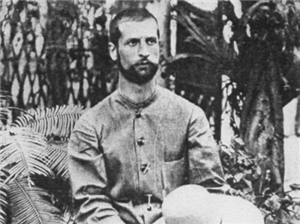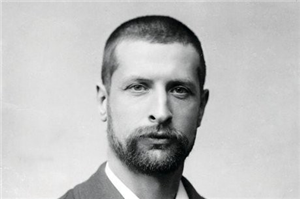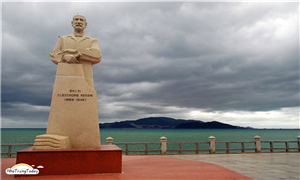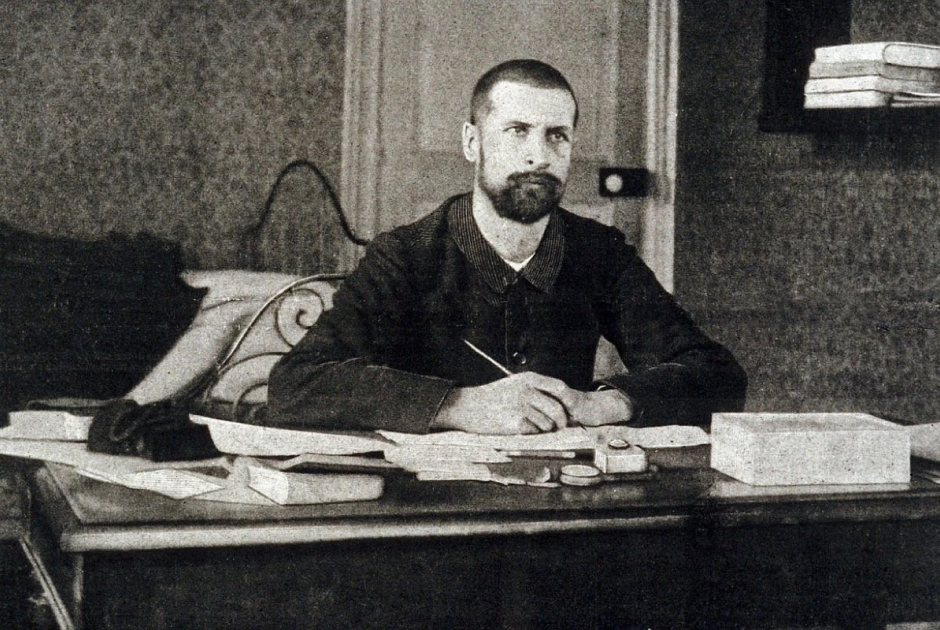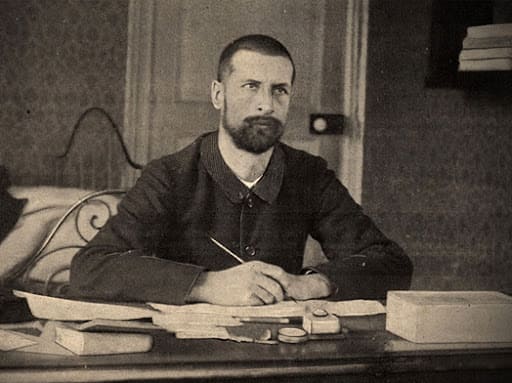Deciding to choose the name Yersin Dalat University, the founders paid tribute to a French scientist whose name and career were closely associated with the land of Indochina and Vietnam, Alexandre John Emile Yersin.
Doctor Alexandre Émile Jean Yersin (1863 – 1943)
YERSIN’S LIFE BIOGRAPHY
On September 22, 1863, Alexandre Yersin was born in a mountainous countryside in Navanux – in the canton of Vaud – Switzerland.
Yersin’s father is a Biology teacher, his mother is from Paris, Yersin is the younger brother in a family of two sisters. With a quiet and humble personality, preferring to live in seclusion, he rarely talked about his life, so now little is known about his childhood days.
At the age of 20 (1883), Yersin studied medicine in Lausanne (Switzerland). Then continued studying at Marbuorg (Germany) and graduated from the University of Paris (France). From 1886, he worked at the Pasteur Institute in Paris and collaborated with Dr. Roux to search for leukemic bacterial toxins. In 1890, he was granted French citizenship.
During his years of diligent research at the Pasteur Institute in Paris, he proved to be a rare genius, a person rich in energy and eager to learn. A bright future opened before his eyes. But Yersin is looking towards a new horizon and wants to find a way out of her current life “I always dreamed of exploring foreign lands, exploring when I was young, I always imagined strange things would come, no There is nothing that cannot be done.”
Then Yersin suddenly left the microbiology field – living a life of sailor and explorer – starting another life lasting 50 years.
JOURNEY TO VIETNAM
First of all, Yersin accepted a job as a doctor for a ship of a shipping company to the Far East. After six months of operating on the Saigon – Manila route (Philippines), Yersin moved to work on the Saigon train, running from Saigon to Hai Phong and vice versa.
The first months in the maritime profession for Yersin were captivating! Yersin has never been in contact with the sea, but during his youth, Yersin became familiar with Léman Lake. While the boat was floating on the ocean, Yersin looked up at the sky and learned how to determine coordinates. When the ship docked, Yersin practiced with the telescope. In the following years, Yersin became fascinated with astronomy and later learned about atmospheric electricity and the solar spectrum.
The train runs on the Hai Phong – Saigon route, sometimes approaching the coast, sometimes crossing the waves offshore. The majestic Truong Son range in the west appears before Yersin’s eyes, evoking memories of his student years. That day, Yersin and his friends climbed the slopes of Valais mountain. Although the Truong Son range does not have the same lines and colors as the Alps, it has strange attractions. Yersin wants to rediscover the feelings of sincerity and intimacy when discovering mysteries and setting foot on a strange land.
In July 1891, Yersin arrived at Nha Trang. He went ashore, walked along the coast to Phan Ri and followed trails over a 1,200 meter high pass near Di Linh. From Di Linh, he intended to go through the forest to Saigon to find a road connecting Nha Trang with Saigon, but he could not catch the train to Hai Phong so he had to abandon the journey and go to Phan Thiet and take a sailboat to Nha Trang.
This short first expedition helped the 30-year-old explorer get acquainted with the difficulties in the tropical mountains – with mountain winds – forest rain – enduring blood-sucking monkeys – crossing water streams. flowing like a waterfall… The first contact with the mountains and forests of the Central Highlands also stimulated Yersin’s desire to do other expeditions.
On March 29, 1892, from Nha Trang to Ninh Hoa, headed straight west to Stung-treng on the banks of the Mekong River.
Thanks to the help of Pasteur and the French Minister of Education; In 1893, Yersin undertook a mission to explore the mountains between the Central Coast and the Mekong River, the upper reaches of the Dong Nai River and Sebangcan that few people knew about until now. Leaving Saigon, he crossed Tri An waterfall to Tanh Linh, crossed La Nga river to Di Linh. Follow a trail similar to current Highway 20. On June 21, 1893, he reached Prenn waterfall and then set foot on Lang Biang.
“On the way, the undulating plateau ranges from 900 meters to 1,200 meters high, about 15 km to 20 km before reaching the foot of the mountain. I stood on a completely bare and grassy area. The uneven hilly land made me feel It’s like walking through an ocean churning with giant waves. Lang Biang Mountain stands tall in the middle like an island and seems to be getting farther and farther away. Gradually when I got closer, the ground was black and full of charcoal. The large herds of deer left us alone for a few hundred meters. The deer ran away and then looked back curiously at us.
At the end of 1893, Yersin went to the Lang Biang plateau again, explored the Dak Lak – A To Po plateau (Laos) and on May 7, 1894 returned to Da Nang.
In 1890, doctor Albelt Calmette established a branch of the Pasteur Institute in Saigon. In 1894, the plague spread throughout Eastern China. Doctor Calmette suggested that Yersin go to China to do on-site research on the plague.
On June 15, 1894, Yersin arrived in Hong Kong and met a rival – doctor Kitasatô who arrived in Hong Kong three days before Yersin. This Japanese doctor is famous for his scientific work in discovering tetanus germs. Yersin built a thatched hut next to the hospital and worked in poor conditions. After only five days of work, on June 20, 1894, he discovered the plague germ. Through the British postal system, he sent test tubes of bacilli to France. The plague bacillus arrived at Pasteur Paris intact and verified, bearing the name Yersin (Yersins Pestis).
In 1895, Yersin founded the Pasteur Institute in Nha Trang and prepared serum to cure the plague. A year later, the epidemic relapsed in China. Yersin went to China again and saved many people from the dangerous disease that killed 50 million people in ancient times.
Yersin returned to Nha Trang, a life began, many problems arose. Realizing that Nha Trang city was built on a white sand area, it was not convenient to expand grass fields to raise horses for serum preparation, he explored the Dau stream area – 10 km south of Nha Trang, and established the city. a livestock and farming farm.
Following the example of his predecessors, he rushed into researching serum to treat the plague for cattle and buffalo. Since then, Nha Trang Pasteur Institute has researched animal and fish bacteria and livestock infections.
During a stopover in Malaysia and Indonesia, Yersin paid close attention to rubber growing. In 1897, he started growing rubber in Suoi Dau and eight years later (1905), Michelia company (France) received the first 1,316 kg of rubber latex. Interested in methods of growing, exploiting and processing rubber, he established an agrochemical laboratory. Here, methods of selecting varieties, tapping and freezing rubber caps were systematically researched and have greatly helped rubber growers in Indochina.
As time passed, the livestock and farming farm at Suoi Dau expanded, Yersin accepted the position of Director of two Pasteur Institutes in Saigon and Nha Trang.
From 1902 to 1903, he went to Hanoi to establish Yersin Indochina University and became the first Rector.
In 1924, he held the position of Inspector General of the Pasteur Institutes in Indochina.
In 1933, he became honorary director of the Pasteur Institute in Paris.
While living in Con village (Nha Trang), he was a kind neighbor, often helping the elderly and fishermen, and loving children. He lived very simply and was full of compassion.
After his trip to India, Governor-General Paul Doumer wanted to build a resort for overseas French like in India. Yersin recommends choosing Dankia – more than 10 km northwest of Da Lat.
In 1899, he accompanied Paul Doumer to Da Lat. After on-site observations, Paul Doumer did not choose Dankia as a resort but chose the current Da Lat location at the suggestion of doctor Emile Tardif because:
– Da Lat is at a higher altitude than Dankia.
– Da Lat’s slope is gentle – Da Lat’s air is more hygienic than in Dankia – there are small hills separated by muddy valleys.
The air in Da Lat is cooler and less humid than in Dankia because Dankia is located near the top of Lang Biang – a mountainside that catches moist winds – receives more rainfall – more fog (it doesn’t clear until 10am).
– Regarding vegetation: Dankia’s side only has small hills, while Da Lat is near pine forests, the air is both cool and fragrant with pine scent.
– Regarding transportation: Da Lat is more convenient than Dankia.
In 1914, World War I broke out. At that time, the Netherlands held the exclusive right to produce Quinine – the only cure for malaria. Yersin tried sowing Canh Ki Na seeds in Dau and Dankia streams.
In 1917, Yersin planted Canh Ki Na trees in Hon Ba – A mountain near Dau stream. At first the tree grew well but later died because the soil was not suitable.
In July 1923, the best Canh Ki Na plants in Hon Ba were planted in Dran and achieved good results. He continued to plant on the small Lang Biang and Di Linh plateaus.
In 1936, Canh Ki Na trees were planted on a large scale in Lan Tranh and Di Linh – 30 tons of bark were harvested with a rate of Quinine Sulphate of 7.42%.
In 1938, 21 tons of shells were obtained with a higher rate of Quinine Sulfate (8.5%).
On June 28, 1935, Yersin High School was inaugurated in Da Lat. Yersin returned to Da Lat for the last time before passing away. On this occasion, responding to a student’s statement, he expressed his feelings when setting foot on the Lang Biang plateau: “The cool air made me forget my fatigue and I remembered my joy.” to run at full speed up and down the hills like a young high school student.”
In the last years of his life, Yersin was still passionate about scientific research – Astronomy – Radio. A few weeks before his death, although his illness increased, he still monitored the tide level.
On March 1, 1943, Yersin passed away peacefully at the age of 80, leaving behind deep grief. Thousands of Nha Trang people brought his spirit to the final resting place at Dau stream.
Coming to Vietnam in the late 19th century and the first half of the 20th century, Yersin worked in the French colonial administration. However, his diverse scientific works – simple life – compassion and love for Vietnam still live forever in the thoughts and feelings of the people of Da Lat – Nha Trang and on our planet. The capital Hanoi – Ho Chi Minh City – Nha Trang city have named Yersin for a street in the city. In Da Lat, the road leading to the current old Yersin High School (College of Education) is named after the French scientist – who bore a heavy love for Vietnam and left unforgettable memories in Da Lat: Alexandre Yersin.
Three memorial sites for Dr. Alexandre Yersin:
– Doctor Yersin’s library at Pasteur Institute Nha Trang, Khanh Hoa province.
– Linh Son Pagoda, Suoi Cat commune, Dien Khanh district, Khanh Hoa province (formerly the doctor’s office in Suoi Dau).
– Doctor Yersin’s grave, Suoi Cat commune, Dien Khanh district, Khanh Hoa province.
In 1891, he came to Nha Trang to build the first microbiology research and experiment facility in Vietnam. In early 1899, this place became Nha Trang Pasteur Institute.
After more than 50 years of living and working for science at the Pasteur Institute of Nha Trang (1891 – 1943), Yersin contributed to science 55 valuable research projects.
Positions he has held:
– Director of Nha Trang Pasteur Institute.
– Director of the Indochina Pasteur Institute.
– Principal of Hanoi Medical University.
– Inspector General of Indochina Pasteur Institutes.
– Academician of the French Academy of Sciences.
– Honorary Chairman of the Medical Council of the Pasteur Institute in Paris.
Deciding to choose the name Yersin Dalat University, the founders paid tribute to a French scientist whose name and career were closely associated with the land of Indochina and Vietnam, Alexandre John Emile Yersin.
The staff and lecturers of Yersin University of Dalat will always make continuous efforts in teaching and scientific research to be worthy of the name, life and career of Doctor Alexandre Yersin.
Collected by Yersin University of Dalat
Some pictures of Doctor Alexandre Yersin

